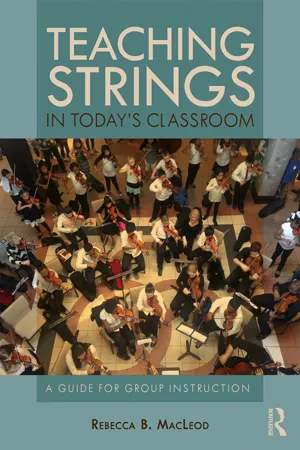
Teaching Strings in Today's Classroom
A Guide for Group Instruction
- 148 pages
- English
- ePUB (mobile friendly)
- Available on iOS & Android
Teaching Strings in Today's Classroom
A Guide for Group Instruction
About this book
Teaching Strings in Today's Classroom: A Guide for Group Instruction assists music education students, in-service teachers, and performers to realize their goals of becoming effective string educators. It introduces readers to the school orchestra environment, presents the foundational concepts needed to teach strings, and provides opportunities for the reader to apply this information. The author describes how becoming an effective string teacher requires three things of equal importance: content knowledge, performance skills, and opportunities to apply the content knowledge and performance skills in a teaching situation.
In two parts, the text addresses the unique context that is teaching strings, a practice with its own objectives and related teaching strategies. Part I (Foundations of Teaching and Learning String Instruments) first presents an overview of the string teaching environment, encouraging the reader to consider how context impacts teaching, followed by practical discussions of instrument sizing and position, chapters on the development of each hand, and instruction for best practices concerning tone production, articulation, and bowing guidelines. Part II (Understanding Fingerings) provides clear guidance for understanding basic finger patterns, positions, and the creation of logical fingerings. String fingerings are abstract and thus difficult to negotiate without years of playing experience—these chapters (and their corresponding interactive online tutorials) distill the content knowledge required to understand string fingerings in a way that non-string players can understand and use.
Teaching Strings in Today's Classroom contains pedagogical information, performance activities, and an online virtual teaching environment with twelve interactive tutorials, three for each of the four string instruments.
ACCOMPANYING VIDEOS CAN BE ACCESSED VIA THE AUTHOR'S WEBSITE: www.teachingstrings.online
Frequently asked questions
- Essential is ideal for learners and professionals who enjoy exploring a wide range of subjects. Access the Essential Library with 800,000+ trusted titles and best-sellers across business, personal growth, and the humanities. Includes unlimited reading time and Standard Read Aloud voice.
- Complete: Perfect for advanced learners and researchers needing full, unrestricted access. Unlock 1.4M+ books across hundreds of subjects, including academic and specialized titles. The Complete Plan also includes advanced features like Premium Read Aloud and Research Assistant.
Please note we cannot support devices running on iOS 13 and Android 7 or earlier. Learn more about using the app.
Information
Part I
Foundations of Teaching and Learning String Instruments
Chapter 1
An Introduction to the Orchestra Classroom
Why Teach Strings?
Culturally Responsive Pedagogy
String Teaching Overview
Table of contents
- Cover
- Half Title
- Title
- Copyright
- Contents
- Preface
- Acknowledgments
- List of Videos
- Part I Foundations of Teaching and Learning String Instruments
- Part II Understanding Fingerings: Patterns and Positions
- Index